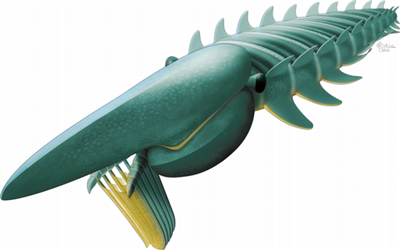(单词翻译:单击)
A huge arthropod that lived 480 million years ago used spines on its head to filter seawater and to trap tiny particles of food. The lobsterlike animal, six feet long, is one of the earliest giant filter-feeder ever discovered, scientists reported in the journal Nature.
4.8亿年前,地球上曾生活着一种大型节肢动物,用头上的骨骼过滤海水,获取食物微粒。科学家们在《自然》(Nature)杂志上报告说,这种龙虾状的动物长六英尺,是迄今发现的最早的大型滤食性动物之一。
“It implies there was a rich source of plankton at the time, upon which these things may have fed,” said Derek Briggs, a paleontologist at Yale University and one of the study’s authors.
“这表明,当时浮游生物资源丰富,这类动物以它们为食,”该项研究的作者之一、耶鲁大学古生物学家德里克·布里格斯(Derek Briggs)说。

Dr. Briggs and his colleagues discovered the fossil remains of the new species, named Aegirocassis benmoulae, in Morocco. It belongs to an extinct family of marine animals called anomalocaridids, which first appeared during the Cambrian Period 520 million years ago.
布里格斯和同事们在摩洛哥发现了这种名为“Aegirocassis benmoulae”的新物种的化石。它属于已灭绝的奇虾属(anomalocaridid)海洋动物,最早是在5.2亿年前的寒武纪出现的。
Aegirocassis had double flaps along the side of its body, rather than the single flaps seen in previous anomalocaridid fossils. The bottom flaps may have helped Aegirocassis swim, while the top set of flaps may have been used for stabilization, Dr. Briggs said.
Aegirocassis benmoulae身体两侧有双鳍,而之前的奇虾属化石都只有单鳍。布里格斯博士说,下侧的鳍可能是用来帮助游动,上面的可能是用来保持身体平衡。
The fossil remains are three-dimensional and exceptionally well preserved. Almost all previous anomalocaridid fossils were flat.
这些化石是三维的,保存得格外完好。之前的所有奇虾属化石几乎都是扁平的。
“We think it is because these things were buried quite rapidly by a storm or other event on the seafloor,” Dr. Briggs said.
“我们认为,原因是这些动物因为风暴或海底的其他动荡而被快速掩埋了,”布里格斯说。


